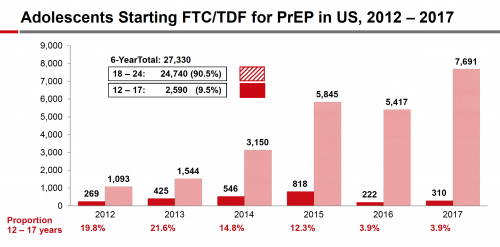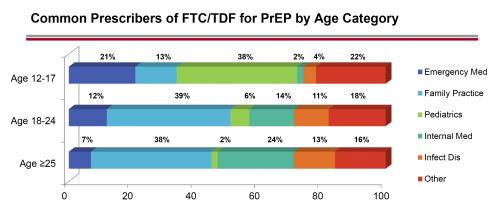A new analysis of the trends of pre-exposure prophylaxis (PrEP) use among young people has found that only about 15 percent of those who have ever started Truvada (tenofovir disoproxil fumarate/emtricitabine) for use as HIV prevention are younger than 25. Use has been particularly scant among teenagers, who made up just 1.5 percent of those who have at least tried PrEP. Interestingly, 84 percent of these teenagers are female.
PrEP, which was approved for adults age 18 and older in July 2012, was approved for adults and adolescents weighing at least 35 kilograms (77 pounds) in May 2018.
According to a just-released estimate from Gilead Sciences, which manufactures Truvada, 180,000 U.S. residents were currently taking the drug for HIV prevention as of mid-2018.
For their analysis on PrEP use among young adults and adolescents, researchers at Gilead analyzed national pharmacy claims data covering January 2012 through December 2017 to determine how many people started PrEP during that period. This data source is limited by the fact that it derives from only 80 percent of U.S. retail pharmacies and does not include prescriptions filled through closed health care systems (such as Kaiser Permanente, a major prescriber of PrEP in Northern California in particular), the Veterans Administration, colleges and universities and active-duty military health care systems.
Considering these limitations, the figures in this analysis are an incomplete representation of the total number of people who have started PrEP in the United States; the true figures are likely greater. Also, if the data source oversamples one age group or sex versus another as a result of such limitations, the findings of this analysis could be further thrown off.
It is further important to note that this analysis looked at the numbers of people starting PrEP each year, rather than the numbers of people currently taking Truvada as prevention. The data source provides no information about whether anyone who started PrEP continued taking it. Additionally, the data available provide no information on whether an individual actually took any Truvada, just that at least one prescription was filled.
Findings were presented at the International AIDS Conference in Amsterdam (AIDS 2018).
During the six-year period analyzed, 177,223 people identified in this data set started PrEP, including 149,893 people age 25 and older (84.6 percent) and 27,330 people ages 12 to 24 (15.4 percent). The number of people age 25 and older who started PrEP was 6,683 in 2012, 9,071 in 2013, 20,819 in 2014, 38,938 in 2015, 35,175 in 2016 and 39,252. (In other words, the rate of annual PrEP starts greatly accelerated between 2012 and 2014 before leveling off.) The number of people ages 12 to 24 who started PrEP was 1,362 in 2012 (17 percent of the total PrEP starts that year), 1,969 in 2013 (17.8 percent), 3,696 in 2014 (15.1 percent), 6,663 in 2015 (14.6 percent), 5,639 in 2016 (13.8 percent) and 8,0001 in 2017 (16.9 percent).

FTC/TDF is shorthand for Truvada. These figures are drawn from a somewhat limited number of U.S. pharmacies, so the true figures of people starting PrEP annually are likely at least somewhat greater.Gilead
Breaking down the adolescent PrEP-start data into two groups, 12- to 17-year-olds and 18- to -24-year-olds, the researchers noted that there were 2,590 people in the younger bracket (9.5 percent) and 24,740 in the older group (90.5 percent) who started PrEP between 2012 and 2017. In 2012, 269 people in the younger age group and 1,093 people in the older age group started PrEP (19.8 percent of the starts this year were among the younger set), while 2013 saw 425 and 1,544 starts (21.6 percent), 2014 saw 546 and 3,150 starts (14.8 percent), 2015 saw 818 and 5,845 starts (12.3 percent), 2016 saw 222 and 5,417 (3.9 percent) and 2017 saw 310 and 7,691 (3.9 percent).

FTC/TDF is shorthand for Truvada. These figures are drawn from a somewhat limited number of U.S. pharmacies, so the true figures of people starting PrEP annually are likely at least somewhat greater.Gilead
Of the 12- to 17-year-olds who started PrEP between 2012 and 2017, 83.5 percent were girls. Of 18- to 24-year-olds who started PrEP during this period, 84.2percent were male. When breaking down the number of starts during this period by age, the researchers found that the groups of 13- and 14-year-olds starting PrEP had the highest proportion of females, at about 92 percent. Then, with each advancing year, the proportion of females declined steadily, hitting 26 percent among 21-year-olds and finally 18.5 percent among 24-year-olds.

FTC/TDF is shorthand for Truvada.Gilead
For the 12- to 17-year-olds, pediatricians were the most common prescribers of an initial PrEP prescription, handling 38 percent of cases. Emergency medicine clinicians prescribed a higher proportion of females’ initial prescriptions in this age bracket (22 percent) compared with males’ (15 percent), while family practitioners prescribed a higher proportion of males’ initial prescriptions (25 percent) compared with females’ (11 percent).
The greatest proportion of initial PrEP prescriptions for both individuals 18 to 24 years old and individuals age 25 and older were handled by family practitioners (39 percent and 38 percent, respectively) and internal medicine physicians (14 percent and 24 percent). Among all those 18 years old and older, emergency medicine physicians’ handled a higher proportion of females’ versus males’ initial prescriptions while family practitioners and internal medicine physicians handled a higher proportion of males’ versus females’ initial prescriptions.

FTC/TDF is shorthand for Truvada.Gilead
Among the 12- to 17-year-old group, 59 percent of initial PrEP prescriptions were covered by Medicaid, 15 percent by commercial insurance, 20 percent by “other” as a category, 5 percent by cash and 1 percent by Medicare. For initial PrEP prescriptions among 18- to 24-year-olds and those age 25 and older, commercial insurance covered 31 percent and 38 percent, respectively, Medicaid covered 22 percent and 13 percent, “other” covered 37 percent and 37 percent, cash covered 9 percent and 9 percent, and Medicare covered 1 percent and 3 percent.

FTC/TDF is shorthand for Truvada.Gilead







Comments
Comments